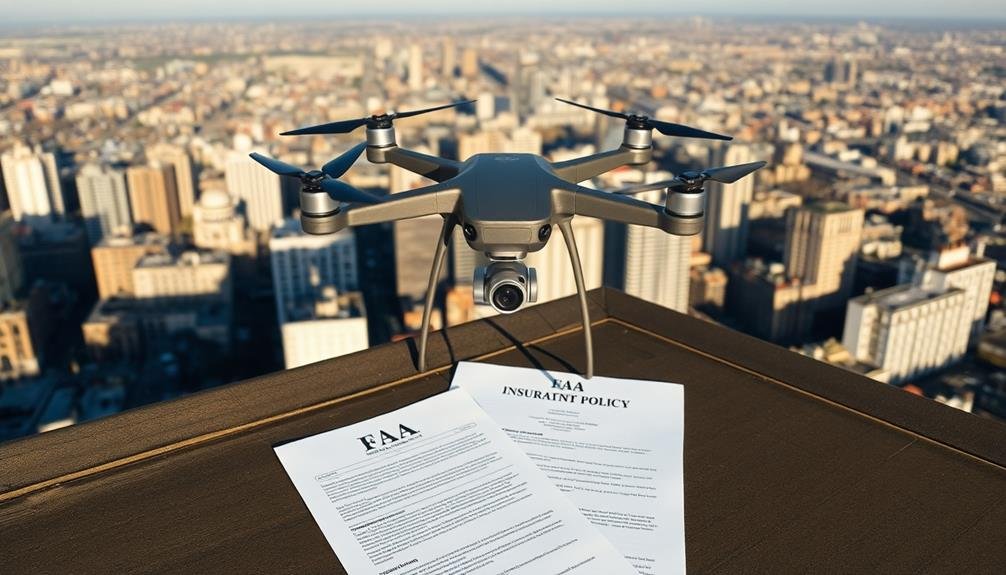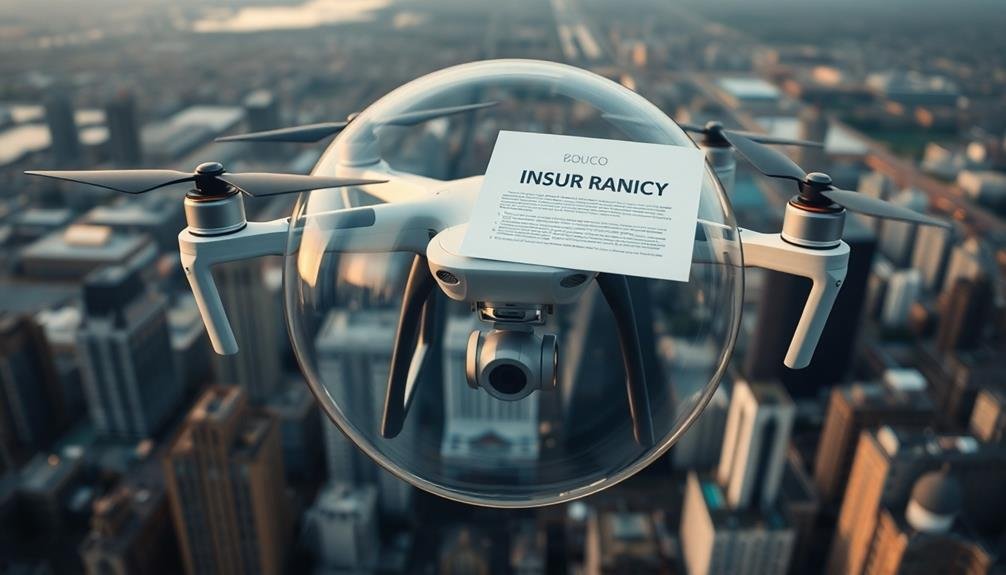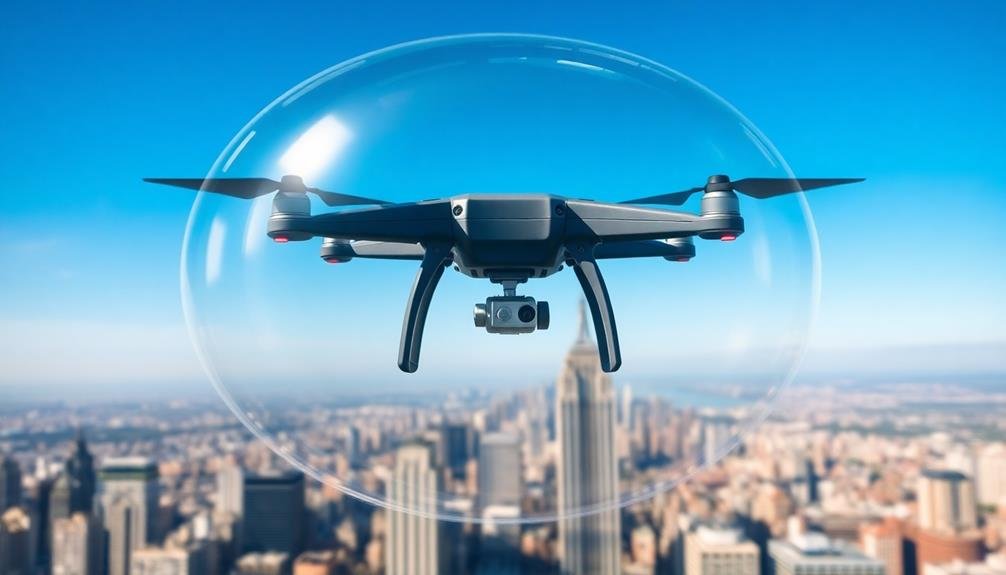As an aerial photographer, you need essential insurance to safeguard your business from various risks. Your coverage should include hull insurance for your drone, liability protection for third-party claims, and payload insurance for your camera equipment. You'll also need to comply with FAA regulations, including obtaining a Remote Pilot Certificate and registering your drone. When choosing an insurance provider, consider their financial stability, industry expertise, and the specific coverage options they offer. Factors like equipment value, flight frequency, and location will influence your premiums. Understanding these elements is vital for protecting your aerial photography venture and ensuring its long-term success.
Key Takeaways
- Understand legal requirements, including FAA certification and local laws, to ensure compliance and minimize risks.
- Assess specific insurance needs based on equipment value, intended use, and potential liability scenarios.
- Choose a financially stable insurer with expertise in drone operations and aerial photography risks.
- Consider hull, liability, payload, and personal injury protection coverages to safeguard against various risks.
- Familiarize yourself with the claims process and document incidents thoroughly to facilitate smooth resolution.
Understanding Aerial Photography Risks

Drones buzzing overhead have become a common sight in the world of aerial photography. As a photographer venturing into this exciting field, you need to understand the unique risks involved.
Your aerial equipment is vulnerable to damage from crashes, collisions, and environmental factors like wind or rain. There's also the potential for your drone to cause property damage or personal injury to bystanders.
You face legal risks too. Violating airspace regulations or privacy laws can lead to hefty fines or lawsuits. Many countries require specific licenses for commercial drone operations, and failure to comply can result in penalties.
There's also the risk of losing or damaging client property during shoots, which could harm your professional reputation and finances.
Cybersecurity is another concern. Your drone's data and control systems could be hacked, potentially compromising client information or leading to equipment loss.
Additionally, you might face liability if your aerial footage inadvertently captures sensitive or restricted areas. Understanding these risks is vital for protecting your business and ensuring you're adequately insured for aerial photography operations.
Types of Drone Insurance Coverage

When it comes to protecting your aerial photography business, several types of drone insurance coverage are significant. You'll need to take into account hull insurance, which covers damage to your drone itself. Liability insurance is essential, protecting you from third-party claims for property damage or bodily injury. Don't forget about payload insurance, which safeguards your expensive camera equipment.
For extensive protection, look into ground equipment coverage for your controllers and other accessories. Personal injury protection is also crucial, covering legal fees if you're sued for invasion of privacy or other personal injury claims.
| Coverage Type | What It Protects | Why It's Important |
|---|---|---|
| Hull | Your drone | Safeguards your investment |
| Liability | Third-party claims | Protects your business assets |
| Payload | Camera equipment | Preserves your tools of trade |
| Ground Equipment | Controllers, accessories | Guarantees operational continuity |
| Personal Injury | Legal fees | Defends against privacy lawsuits |
Legal Requirements for Drone Operators

Generally, operating a drone for commercial purposes involves maneuvering a complex web of legal requirements. As a drone operator, you must first obtain a Remote Pilot Certificate from the Federal Aviation Administration (FAA). This certification requires passing an aeronautical knowledge test and undergoing a background check.
You'll need to register your drone with the FAA if it weighs more than 0.55 pounds. Each aircraft must display its registration number visibly.
You're also required to follow FAA regulations, including flying below 400 feet, maintaining visual line of sight, and avoiding restricted airspace.
Local laws may impose additional restrictions, so it's essential to research regulations specific to your area. Some locations require permits for commercial drone operations or have designated no-fly zones.
Privacy laws are another consideration. You must respect individuals' right to privacy and avoid capturing images or footage without consent when required.
Lastly, you'll need to comply with any industry-specific regulations. For example, if you're using drones for real estate photography, you may need to adhere to guidelines set by the National Association of Realtors.
Assessing Your Insurance Needs

To determine your aerial insurance needs, you'll want to compare different coverage types and assess your specific risks.
Consider factors like your drone's value, intended use, and potential liability scenarios.
Evaluate thorough policies that protect against equipment damage, third-party injuries, and privacy violations to guarantee you're adequately covered.
Coverage Types Comparison
In the domain of aerial insurance, understanding different coverage types is vital for evaluating your specific needs. As a drone photographer, you'll encounter various policies tailored to aerial operations. These include liability coverage, hull insurance, and payload protection. Each type offers distinct benefits and addresses specific risks associated with your aerial photography business.
When comparing coverage types, consider the following key factors:
- Liability limits and exclusions
- Equipment replacement costs
- Geographic restrictions
- Operator qualifications and training requirements
- Additional endorsements for specialized operations
Liability coverage protects you against third-party claims for property damage or bodily injury caused by your drone operations. Hull insurance safeguards your equipment against physical damage, theft, or loss. Payload protection covers cameras and other attached gear. Some policies combine these coverages, while others offer them separately.
You'll also find variations in coverage limits, deductibles, and premiums across different insurers. It's important to carefully review policy terms and conditions to guarantee they align with your business activities.
Don't hesitate to ask insurers for clarification on specific coverage details or exclusions. By thoroughly comparing coverage types, you'll be better equipped to select the most suitable insurance plan for your aerial photography business.
Risk Assessment Strategies
After comparing coverage types, it's time to assess your specific insurance needs.
Start by evaluating your drone operations' scope and frequency. Consider the types of projects you undertake, the locations you fly in, and the clients you serve. Each of these factors plays a significant role in determining your risk exposure.
Next, analyze your equipment's value and replacement costs. Include not only your drone but also cameras, sensors, and other accessories.
Don't forget to factor in potential business interruption costs if your equipment is damaged or stolen.
Assess your liability risks by considering worst-case scenarios. What if your drone causes property damage or injures someone?
Think about the potential financial impact of such incidents on your business.
Review your existing insurance policies to identify any gaps in coverage. Your general liability policy may not cover drone-related incidents, so you'll need to address these specifically.
Choosing the Right Insurance Provider

When selecting an aerial insurance provider, you'll want to compare coverage options to guarantee they align with your specific needs.
It's vital to assess the financial stability of potential insurers, as this impacts their ability to pay claims.
Additionally, you should evaluate each provider's industry expertise to make sure they understand the unique risks associated with aerial operations.
Compare Coverage Options
Frequently, drone operators find themselves overwhelmed by the variety of insurance options available. To make an informed decision, you'll need to compare coverage options carefully. Start by identifying your specific needs based on your aerial photography projects and potential risks.
When comparing coverage options, consider these key factors:
- Liability limits: Verify they're adequate for your projects
- Equipment coverage: Check if it includes your drone and accessories
- Personal injury protection: Look for coverage against privacy violations
- Ground equipment coverage: Verify if it includes your cameras and other gear
- Geographical limitations: Confirm coverage in areas where you'll operate
Don't just focus on premiums; examine deductibles, exclusions, and policy limits. Some providers offer specialized drone insurance packages, while others include drone coverage in their general liability policies. You'll want to evaluate which option best suits your business model.
Remember to review each policy's claims process and customer support. A provider with efficient claim handling and responsive customer service can be invaluable when you need to file a claim.
Assess Financial Stability
Once you've narrowed down your insurance options, it's time to scrutinize the financial stability of potential providers. This step is essential in ensuring that your chosen insurer can fulfill its financial obligations if you need to make a claim.
Start by checking the insurance company's financial strength ratings from independent agencies like A.M. Best, Moody's, or Standard & Poor's. These ratings indicate the insurer's ability to pay claims and withstand economic downturns. Look for providers with ratings of A or higher, as they're considered financially stable.
Next, research the company's history and reputation. How long have they been in business? Do they've experience with aerial photography insurance?
Check online reviews and testimonials from other photographers to gauge customer satisfaction and claim handling efficiency.
Consider the insurer's size and market share. Larger companies often have more financial resources but may offer less personalized service.
Smaller insurers might provide more tailored coverage but could be more vulnerable to market fluctuations.
Evaluate Industry Expertise
Beyond financial stability, it's crucial to evaluate an insurance provider's industry expertise. When selecting aerial insurance for your photography business, look for companies that specialize in drone coverage or have a dedicated department for unmanned aerial systems. These providers will better understand the unique risks and challenges associated with drone operations.
To assess an insurer's industry expertise, consider the following:
- Length of time they've offered drone insurance
- Depth of knowledge about FAA regulations and compliance
- Ability to provide tailored coverage for specific drone models and uses
- Experience in handling drone-related claims
- Partnerships with drone manufacturers or industry associations
Don't hesitate to ask potential insurers about their experience with aerial photography businesses.
Inquire about any additional resources they offer, such as risk management tools or training programs. A provider with genuine industry expertise will be able to answer your questions confidently and provide examples of how they've helped similar businesses.
Cost Factors in Drone Insurance

Several factors come into play when determining the cost of drone insurance. The value of your drone equipment is a primary factor, as more expensive drones typically require higher coverage limits and premiums.
Your level of experience as a drone operator also impacts costs, with seasoned pilots often qualifying for lower rates due to their reduced risk profile.
The type of work you're doing with your drone affects pricing too. High-risk operations, such as flying over populated areas or conducting inspections in hazardous environments, usually lead to higher premiums.
Your flight frequency matters as well; the more often you fly, the more you'll likely pay for coverage.
Geographic location plays a role, with urban areas generally commanding higher rates than rural ones.
The coverage limits you choose will directly influence your costs, so carefully assess your needs. Don't forget to evaluate additional coverages like ground equipment protection or personal injury liability.
Claims Process for Aerial Incidents

Filing a claim for an aerial incident can be an intimidating process, but understanding the steps involved will help you navigate it more smoothly.
When you're faced with an aerial incident, act quickly and document everything. Contact your insurance provider immediately and provide them with a detailed account of what happened.
Your insurer will guide you through the claims process, but here's what you can expect:
- Incident report submission
- Evidence collection (photos, videos, witness statements)
- Damage assessment by an adjuster
- Review of your policy coverage
- Determination of claim approval or denial
Be prepared to provide all necessary documentation, including flight logs, maintenance records, and any relevant permits or certifications.
Your insurer may request additional information or conduct an investigation if needed.
Frequently Asked Questions
Can I Add Drone Insurance to My Existing Photography Business Insurance Policy?
You can often add drone insurance to your existing photography business policy. Contact your insurance provider to discuss adding this coverage. They'll assess your needs and may offer an endorsement or separate policy for drone operations.
Are There Any Discounts Available for Certified or Experienced Drone Operators?
Yes, you'll often find discounts for certified or experienced drone operators. Insurance companies value your expertise and may offer reduced rates. Be sure to highlight your certifications and flight hours when applying for coverage to maximize potential savings.
How Does Flying Indoors Affect My Insurance Coverage?
Flying indoors can affect your insurance coverage differently. You'll need to check your policy specifics, as many standard drone insurance plans don't cover indoor flights. You might need additional coverage or a separate policy for indoor operations.
What Happens if I Accidentally Capture Images of Restricted Areas?
You'll face legal consequences if you capture restricted areas. It's your responsibility to know and avoid no-fly zones. Delete any accidental images immediately and report the incident to authorities if required. Don't share or publish these photos.
Does Drone Insurance Cover Damage to the Drone During Transportation?
You'll need to check your specific policy, but many drone insurance plans don't cover transportation damage. It's often considered separate from flight risks. You might want to look into additional equipment insurance for complete protection.
In Summary
You've now got the tools to protect your aerial photography business. Remember, insurance isn't just a legal requirement—it's your safety net. Don't skimp on coverage; assess your needs carefully and choose a provider that understands your unique risks. Stay informed about changing regulations and update your policy as needed. With the right insurance in place, you'll be free to focus on capturing stunning aerial shots without worry.

As educators and advocates for responsible drone use, we’re committed to sharing our knowledge and expertise with aspiring aerial photographers.




Leave a Reply